It’s pretty hard to win in the playoffs when you have the worse goalie and are massively outplayed on special teams.
For the second time in three games, that was the case for the Toronto Maple Leafs against the Boston Bruins, and it’s put the Leafs in a 2-1 series hole. Home-ice advantage has been ceded back to Boston, and the Leafs now have to regroup before dealing with a hugely important Game 4 on Saturday night. They’ll need to figure out how to solve Jeremy Swayman and fix the special teams to avoid a 3-1 hole.
Turning Points
Our turning points in Game 3 were two of the three goals scored by the Bruins, both occurring when control of the game and momentum may have been tilting Toronto’s way.
The first turning point was Boston’s first goal, coming in the later stages of the second period. After a pretty low event first period and a half, the Maple Leafs finally opened the scoring to take a 1-0 lead. In the subsequent minutes, they received a huge save from Ilya Samsonov on a breakaway by James van Riemsdyk and then started to tilt the ice back the other way. The fourth line put in a good shift, and then the second line continued the momentum, with the Leafs getting multiple chances to double their lead.
The Leafs had energy, the building was buzzing, and it felt like they were in control. They were the better team up to that point, but before they could get the second goal — or even really consolidate their lead — a nightmare shift unfolded.
First, there was the ref show dimension — the takedown of Auston Matthews by Charlie McAvoy, and then additional hijinks at center ice by Brad Marchand and Tyler Bertuzzi, all of which went uncalled. It is what it is, but the main problem with the play is Ilya Samsonov letting in a howler — a woeful goal to allow on a non-threatening shot by Trent Frederic down the wing. He can’t give this goal up against a non-elite shooter with no screen. Samsonov had been very sharp up to that point, but that goal was a killer that let the air out of the balloon in the arena.
The third period hadn’t really gone how the Leafs wanted it to go, giving up an early goal to make it 2-1 Boston, but Toronto kept battling and eventually tied it. With under 10 minutes to go, the Leafs were back on even footing and again had the crowd alive again in the building. Morgan Rielly’s shot (deflected in by Tyler Bertuzzi and Hampus Lindholm’s skates) was his first notable moment of the series, and the Leafs were finally able to figure out the excellent goaltending of Jeremy Swayman.
The Leafs left the top line on the ice, and they immediately got scored on after a comedy of errors in the defensive zone starting with a weak play from Timothy Liljegren. As we’ve seen too many times with Liljegren in the playoffs, he was overwhelmed by forecheck pressure and made a weak play on the puck, turning it over into a contested puck battle. The Leafs held the numbers advantage on the puck battle, but Matthews and Edmundson lost it, and to add insult to injury, Matthews knocked the stick out of Ilya Samsonov’s hand. The puck came out from the scrum and right onto the tape of Brad Marchand, who placed an excellent shot by Samsonov, who awkwardly lunged at it without his stick.
Just 28 seconds after tying the game, the Leafs handed the lead right back to Boston and now had only ~eight minutes to tie the game again. It ultimately proved to be a mountain too difficult to climb. The Leafs’ response immediately after scoring — both their 1-1 and 2-2 goals, with the JVR breakaway against, then a Marchand game-winner — was again a head-scratching problem on home ice.
Notable Performances
After a dazzling Game 2, this one was a bit of a comedown for Auston Matthews. I don’t think Matthews was terrible, but his line wasn’t as effective as they had been previously, and they gave up that crushing third goal right after the equalizer. Matthews didn’t have a point and didn’t seem as dangerous with only three shots on goal in over 23 minutes of ice time. One that didn’t count as a shot on goal was a rip he put off the post on an abbreviated 2v1, his most dangerous moment of the night. That was nice, but a second goal-less games out of three to start the series, allied a below-water night in the shot attempts and expected goals in Game 3, is not ideal for the 69-goal scorer.
Tyler Bertuzzi had a pretty frustrating night overall, fanning on a power-play opportunity right after he had two chances at the net front — one of which came with an exposed net — that he shot into Swayman’s pads. He also took an undisciplined, costly penalty late in the second period, negating the power play and leading to the 2-1 Boston goal. Of course, he got credit for the second goal — a lucky bounce, but he went to the right spot. I thought Max Domi was much better on that line — really dangerous with the puck, creating time and space for himself, and fooling defenders in the offensive zone. His performances at 5v5 and the continued failures of the power play make me wonder if we will see Domi on the top unit soon.
The second line of Mitch Marner, John Tavares, and Matthew Knies had a bounce-back night, scoring the first goal on a marvelous pass by Marner to Knies. They weren’t doing a whole lot before then, but the goal seemed to go to their legs, and there were multiple more chances for Knies thereafter, not to mention that Tavares drilled the crossbar earlier in the game. Marner played a better game, although it was strange that the performance didn’t seem to translate to other lines. It mostly didn’t go well when Sheldon Keefe hunted matchups and tried to bump Marner onto other lines. Marner’s shifts with the Matthews line were some of the worst shifts (territorially) that Matthews had all game. It was a night of progress for #16 overall, but his performance still is not quite where you want it to be.
The third line with Calle Järnkrok, Nick Robertson, and Pontus Holmberg didn’t particularly bother me. They created the team’s best chance after the Bruins went back ahead 3-2 — looks for both Robertson and Järnkrok — and there was a rush earlier in the game where Robertson’s pass for the Swede was just off the mark, which would’ve created an A+ opportunity. They didn’t play a ton, with Robertson and Holmberg again sitting down near 10 minutes of ice time, but they didn’t inflict any damage defensively and generated a nice momentum shift later in the third.
The fourth line was an interesting group to evaluate, with a bit of a divide between eye test and analytics. In the eye test, I liked the fourth line again. They helped set the tone early, with Ryan Reaves‘ thundering hit on Pavel Zacha helping to get the crowd into the game. Connor Dewar has continued to impress me in this playoff trial. David Kämpf‘s showing on the penalty kill was pretty disappointing, but I thought he looked fine at 5v5. Yet this group got caved in in the underlying numbers, way out-shot and out-chanced while on the ice. Sometimes, you can lose the territorial battle while not registering in that way from a visual standpoint.
Defensively, the Timothy Liljegren and Joel Edmundson pair lost their minutes again, and it makes me wonder if we will see a change there before Game 4. Liljegren had a poor game, in my opinion, firing a shot into the shins of van Riemsdyk to create a breakaway the other way early in the third (JVR hit the post) before taking a lot of the blame on the game-winning goal. As for Edmundson, he was out there for a PK goal and a 5v5 goal against, but he wasn’t really the blame-worthy party. He blocked a David Pasrnak shot that would be a sure goal otherwise and jumped into the rush nicely on the Knies goal.
Morgan Rielly finally made an impact on the series, taking the shot that ended up in the net off the skate of Bertuzzi, but I’m still waiting for him to truly ascend the way we saw him do in the last couple of playoffs. He hasn’t been as impactful off the rush and assertive in the offensive zone as we’re accustomed to in the playoffs. Ilya Lyubushkin let van Riemsdyk behind him after firing a shot into bodies at 1-1, which wasn’t a highlight, and came away with the worst underlying numbers on the defense.
The second pair, Simon Benoit and Jake McCabe, graded out the best analytically. Benoit put a puck out of play and took an early penalty, but otherwise, this duo settled in and wasn’t too noticeable. For a pair of defensemen who played 6-7 five-on-five minutes against Pastrnak, that’s certainly not the worst thing to say, especially not when it’s a bit of a rollercoaster with several of the other options on the back end.
In net, Ilya Samsonov had an up-and-down game somewhat reminiscent of longtime NHL goalie Mike Smith; he made several difficult saves but gave up a dreadful goal all the same. Samsonov wasn’t bad, with a couple of really important saves on breakaways. I also thought he was very sharp on the Leafs’ first penalty kill early in the game, which helped get the Leafs into the game. Up until the first goal for the Bruins, I would’ve said Samsonov was very good and one of the better players on the Leafs.
But that first goal cannot go in, and as we noted in the turning points section, it had a devastating effect on the game. Sometimes, it’s not always how many saves you make, but which ones and when. Samsonov has generally been a good playoff goalie for the Leafs, but this is the second time he’s allowed an ugly goal on a harmless, unscreened wrist shot from far out that swung momentum in a playoff game at home (see: Florida G2 last year). Again, Samsonov isn’t sinking the Leafs, but he’s been clearly worse than Jeremy Swayman in both of their two matchups in this series, and that’s a problem for the Leafs.
Storylines for Game 4
1. William Nylander’s health. Another game, another post-game analysis with William Nylander’s health as the top storyline. It seems like #88 has been progressing positively — from not on the ice before Game 1, to on the ice before Game 2 but not taking line rushes, to taking line rushes before Game 3. But he still hasn’t been in the lineup, and the Leafs desperately need him. His speed and offense are badly needed on the power play, and his game-breaking ability and puck transportation skills would be key to cracking Boston’s defensive and neutral zone structure at five-on-five. Leafs Nation has to hope that the extra day off before Game 4 will pay dividends with Nylander’s health.
2. Lineup changes on defense? We asked this question after Game 2, but I think the logic of “we didn’t make changes after a loss; why would we change it up after a win?” was ultimately persuasive for Sheldon Keefe. Now, after another loss, will he make a change? For the sake of the penalty kill, TJ Brodie remains an option. After a tough night for Liljegren (now down 3-1 in 5v5 goals and just a 33% xGF for the series) and an iffy Lyubushkin, it’s not like they’re out of options on who to take out of the lineup.
3. Line deployment on home ice. Our own Anthony Petrielli wrote about this in the Game in 10 last night, but Sheldon Keefe unsurprisingly decided to use home ice to hunt matchups. He loaded up ice time for his top guys and flipped lines around, moving Marner onto several different lines he did not play on normally rather than rolling four lines as early as the first period. The result was another loss on home ice in the playoffs as the Leafs have amazingly not won a playoff game at home since Game 2 against Tampa last season (0-for-the-last-5 now). After a game that was the most tilted in Boston’s favour of the three in the series, maybe the Leafs’ coach should go back to rolling his lines rather than hunting and tinkering so much.
4. Special teams scuffling. This series is currently being decided on special teams more than anywhere else. The 5v5 play has been reasonably even, if not tilting to the Leafs over three games. But they are getting killed on special teams, and thus Boston holds a 2-1 series advantage. Five years may have passed since that 2019 series, but the Maple Leafs continue to have no answers for Boston’s PP, and it’s costing them in a first-round series. The Bruins have scored a PPG in each of the three games in this series, and it’s difficult to envision the Leafs advancing if this continues.
Likewise, the power play remains a major problem after an empty performance in Game 3 on more than a couple of opportunities. Getting Nylander back could freshen up the man advantage, as his puck transportation can give the Leafs possession into the zone (less of an issue in Game 3 but an issue earlier in the series), not to mention his shooting and passing ability. But even if Nylander can’t play, the current results are unacceptable when something like $40+ M in salary is put on the ice together. The PP currently looks uncoordinated and disjointed, like players don’t know where their teammates on the ice are going to be. The Leafs must also hunt Matthews’ shot more aggressively on the PP and play for rebounds. Guy Boucher’s job is probably on the line with the power play’s performance moving forward.
5. Solving Swayman. I assume that Boston will break their habit of rotating goalies after an excellent effort from netminder Jeremy Swayman in Game 3. If it is Swayman back in that net, the Leafs have to figure out how to get goals by him. Through five games against the Alaskan this season, the Leafs have just seven goals and Swayman boasts a .957 SV% in those games. While the Leafs have had some success against Linus Ullmark in the season series, they’ve had no answers for Swayman. The young goalie is indeed a rising star in the league, but he’s not a .960 goalie (no one is). The Leafs must figure out how to break out of this funk against him.
As we always talk about in the playoffs, it comes down to putting shots on net, taking the eyes away, and playing for rebounds and screened shots. If Swayman is seeing it, he is stopping it right now. The Leafs in Game 3 didn’t challenge Swayman enough in the way of high-danger opportunities, credited with only 1.3 expected goals for at 5v5 (3.03 for the full game). They need to make life more difficult on Swayman, and when opportunities present themselves, finishers have to finish.


![Craig Berube Post Game, Blues 5 vs. Leafs 1: “We gave them three goals… The [3-1] goal was lazy hockey” Craig Berube, Toronto Maple Leafs head coach](https://mapleleafshotstove.com/wp-content/uploads/2024/10/berube-craig-lak-pg-218x150.jpg)



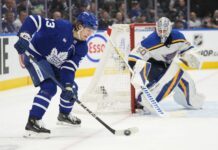
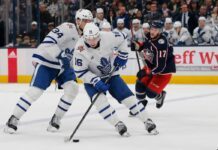
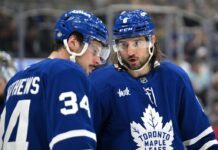



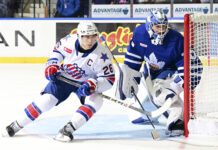











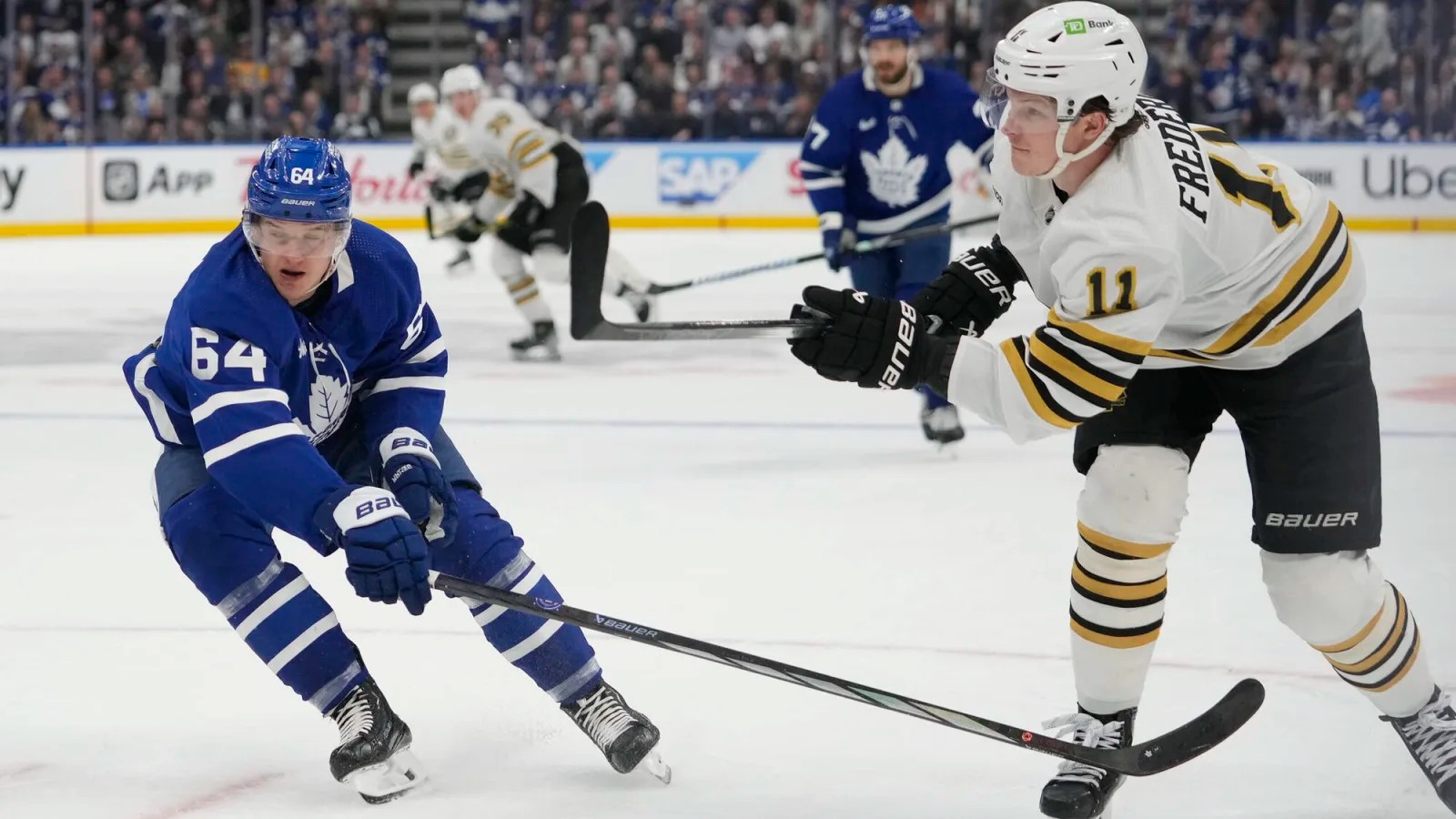
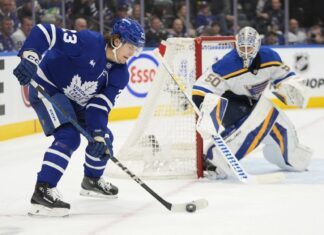
![Craig Berube Post Game, Blues 5 vs. Leafs 1: “We gave them three goals… The [3-1] goal was lazy hockey” Craig Berube, Toronto Maple Leafs head coach](https://mapleleafshotstove.com/wp-content/uploads/2024/10/berube-craig-lak-pg-100x70.jpg)






![Craig Berube Post Game, Leafs 5 vs. Lightning 2: “[Stolarz] is a quality, quality goalie… He’s been excellent for us” Craig Berube, Toronto Maple Leafs head coach](https://mapleleafshotstove.com/wp-content/uploads/2024/09/berube-pg-tor-100x70.jpg)
